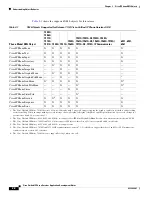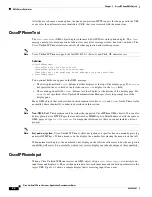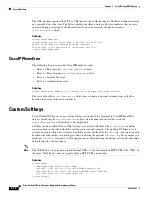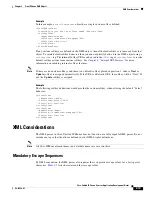
2-14
Cisco Unified IP Phone Services Application Development Notes
OL-18696-01
Chapter 2 CiscoIPPhone XML Objects
XML Object Definitions
CiscoIPPhoneStatus
The CiscoIPPhoneStatus object is also a displayable object, but differs from the preceding objects in that
it displays on the Call plane of the phone rather than the Services plane. The CiscoIPPhoneStatus object
“hovers” above the Call plane and is typically used in conjunction with CTI applications to present
application status to the user.
The Status object cannot be closed or cleared by the user (for example, by pressing Services) because
the Status object is only present on the Call plane. In order to clear the object, the phone must execute
the Init:AppStatus URI. This would typically occur as the result of an application server pushing an
Execute object to the phone that contains the Init:AppStatus URI.
Note
The CiscoIPPhoneStatus object can only be pushed (HTTP POST) to the phone; it cannot be pulled
(HTTP GET).
The CiscoIPPhoneStatus object can be refreshed or replaced at any time. It is not necessary to clear an
existing Status object before sending a new Status object. The new object simply replaces the old object.
Figure 2-8
shows the CiscoIPPhoneStatus object that contains the following visual elements:
•
106 x 21 graphics area for displaying CIP images (same image format as CiscoIPPhoneImage)
•
Seedable, free-running timer (optional)
•
Single-line text area (optional)
Figure 2-8
IconMenu on a CiscoIPPhoneStatus Sample
Definition
<CiscoIPPhoneStatus>
<Text>This is the text area</Text>
<Timer>Timer seed value in seconds</Timer>
<LocationX>Horizontal alignment</LocationX>
<LocationY>Vertical alignment</LocationY>
<Width>Pixel width of graphic</Width>
<Height>Pixel height of graphic</Height>
<Depth>Color depth in bits</Depth>
<Data>Hex binary image data</Data>
</CiscoIPPhoneStatus>
Dynamic Sizing of the Application Status Window
You can enable applications to dynamically adjust their window sizes based on the displayed content.
The minimum size requirements limit the windows size so that it is a large enough size to stand out from
the Overview content. For example, using a smaller window for an application allows more content from
the Overview to be displayed. Sizing the window occurs upon the reception of a CiscoIPPhoneStatus or
CiscoIPPhoneStatusFile object with its associated PNG file.
















































